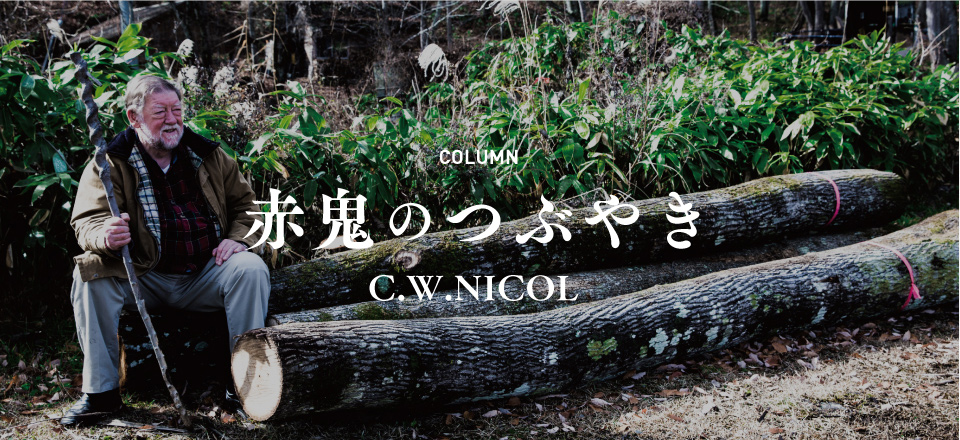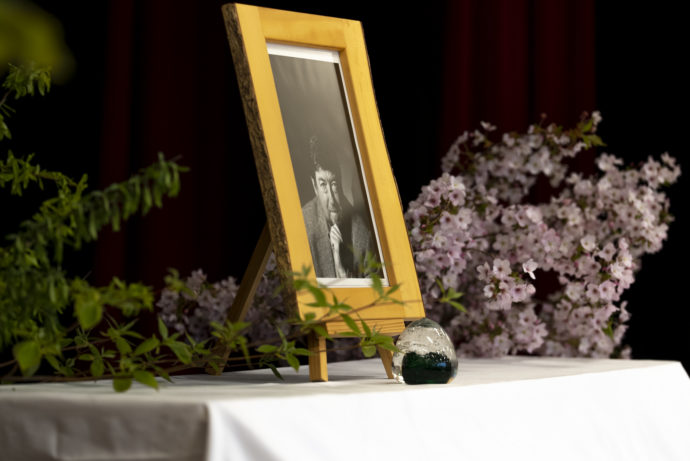Column
【赤鬼のつぶやき C.W.ニコル】クルミ(Walnut)
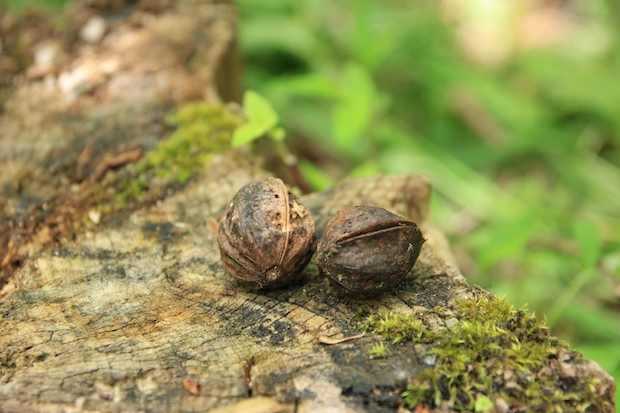
クルミといえば、イギリスっ子にはなくてはならないおやつです。少年時代に冬休みを過ごした祖父の家のテーブルにはガラス細工の大きなボウルに入ったたくさんのクルミの実、そしてクルミ割り器が置いてありました。クルミを割ったら実を口の中へ、殻は燃えさかる暖炉の炎の中へ放り込みます。祖母は、「ナッツを食べれば頭が良くなるよ」と、よく言っていたものです。当時は、殻の中のクルミの実の形がちょっと「脳みそ」に似ているからだと思っていました。そして祖母が話していた通り、クルミの実にはタンパク質と必須脂肪酸がたっぷりと含まれているのです。スープやシチューに入れると味に深いコクが出るし、細かくクラッシュしてあるクルミは、アップルパイにケーキ、ビスケットやパンにもよく合います。

アファンの森にもオニグルミがあります。オニグルミの葉や、まだ青い実の殻、そして根は、まわりの植物の成長を邪魔する毒素を出しています。この「ユグロン」が水に溶けると水生昆虫や小さな魚を殺してしまうほどの毒性があるので、アファンの森では小川や池のまわりのオニグルミは伐ってしまいました。
クルミ材はウォールナットと呼ばれ、ヨーロッパや北米で家具の材料や床材として重宝されています。硬くて軽くまっすぐな幹はとても加工しやすいのですが、日本でクルミは材としてはないがしろにされています。でも、長い付き合いのある友人の一人ですばらしい木工デザイナーでもある稲本正さんが、アファンセンターの家具を作るときオニグルミを喜んで使ってくれました。稲本さんの会社で働いている伝統技術を受け継いだ家具職人の方は、おそらく日本で初めての試みとして、表面を漆で仕上げたクルミ材のテーブルを作りました(最初のうちは、そのアイディアは冗談だと思われていましたが)。できあがったテーブルは美しく、とても軽くて、なによりずっと大切に使い続けたいものになったと思います。
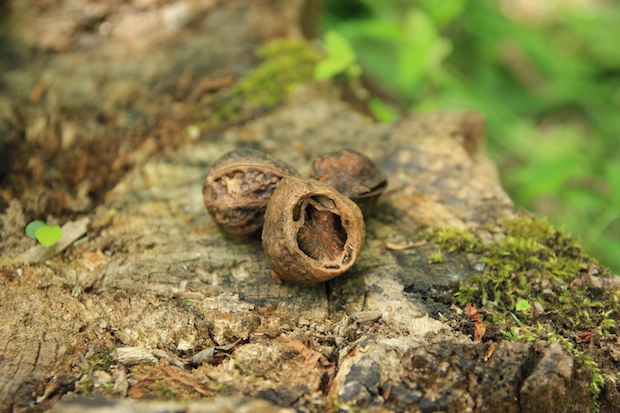
リスそして森に棲むネズミの仲間たちは、まだ殻が青く若いクルミの実には見向きもしませんが、熟したクルミは大好物。クルミの硬い殻に小さな丸い穴があいていたら、ネズミにかじられた跡でしょう。リスがクルミを食べたあとの殻は、まっぷたつに割れて落ちているはずです。
アメリカの在来種である「クログルミ」「シログルミ」は、真菌に侵されると根元にコブができやすく、病気に強いオニグルミが日本からたくさん移植されています。オニグルミの実はほかのクルミよりも一回り小さくて殻を取り除くのも骨が折れるものの、中の実は甘く、クルミ割りに精を出すだけの価値あるおいしさです。
ヨーロッパでは、といっても遠い昔のことですが、クルミの殻は染料やインクに用いられ、レオナルド・ダ・ヴィンチやレンブラントも絵を描くときに使っていたといわれています。
日本の森林行政は、建築資材として使うスギやヒノキ以外のクルミなどの木を「雑木(ざつぼく)」と呼んでいます。「雑」つまり使いみちがないムダな木なんて、この世には一本もないと思うのですが!
C.W.ニコル
2016年5月23日
写真提供:C.W.ニコル・アファンの森財団
(日本語訳:津久井 文)
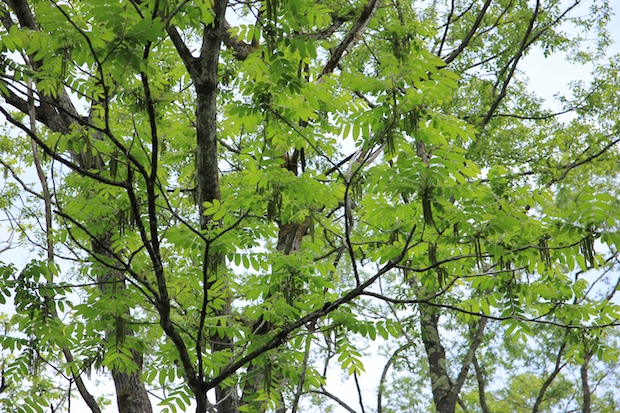
As a boy growing up in Britain, walnuts were a very important and common food. In my grandparents’ house, during winter, there was a big cut-glass bowl of nuts on the table, together with a nutcracker. You could snack on nuts whenever you liked, as long as you tossed the shells into the fireplace. My grandmother used to say that walnuts were ‘good for the brain.’ As a boy I used to think that this was because the nut, once out of its shell, looks a bit like a human brain. Actually, walnut flesh is high in protein and essential acids. I love to use walnuts in cooking, as a thickener for soups and stews, and with crushed walnut to add to apple pies, cakes, biscuits and even bread.
‘Oni gurumi’ is very common in our Afan woods. The leaves, green husks and even roots exude a toxin called ‘juglone’ which inhibits the growth of other plants, and which can also kill water insects and small fish. That is why we have taken out a lot of ‘oni gurumi’ trees, especially around our streams and ponds.

Walnut wood is highly prized in Europe and North America for furniture and flooring. It is hard, light, and with a generally straight grain that is easy to work with. Many Japanese are scornful of walnut wood, but my good old friend the famous furniture designer Inamoto Tadashi was happy to use ‘oni gurumi’ in the making of the tables in our Afan Centre, and was the first to use Japanese ‘urushi’ lacquer (even those his traditional craftsmen at first scorned the idea.) The result is beautiful, light and without a doubt, long lasting furniture.
Squirrels and small woodland mice won’t touch the green husks, but love the nuts. If a mouse has eaten walnut flesh you can always tell because a small round hole has been nibbled through the tough shell. If a squirrel has eaten a walnut, the nut has been split into two halves.

Japanese ‘oni gurumi’ is resistant to a canker tree disease caused by a fungus that commonly infects the American ‘black’ or ‘butternut” walnut, which is one of the reasons that ‘oni gurumi’ trees have been extensively imported into America.
The nuts of Japanese ‘oni gurumi’ are rather small and touch to crack, but the meat is sweet and worth the effort.
In Europe, in olden times, walnut husks were used for dyes and for making ink, ink that apparently was used by Leonardo da Vinci and Rembrant.
As I say, although Japanese Forestry Agency people often use the term ‘zatsu boku’ (useless tree) there is no such thing as a ‘zatsu’ tree!
C.W.Nicol
May 23rd. 2016
C.W.ニコル
作家・1940年イギリス南ウェールズ生まれ。1995年日本国籍取得。カナダ水産調査局北極生物研究所の技官・環境局の環境問題緊急対策官やエチオピアのシミエン山岳国立公園の公園長など世界各地で環境保護活動を行い、1980年から長野県在住。1984年から荒れ果てた里山を購入し「アファンの森」と名づけ、森の再生活動を始める。2005年、その活動が認められエリザベス女王から名誉大英勲章を賜る。2011年、2016年に天皇、皇后両陛下がアファンの森をご視察された。


